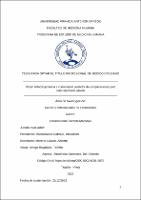Razón linfocito/proteína c como factor predictor de complicaciones post colecistectomía abierta
Resumen
OBJETIVO: Comprobar que la razón linfocito/PCR (RLP) es un útil predictor de complicaciones post quirúrgicas de la colecistectomía abierta.
MÉTODO: Se realizó un estudio de pruebas diagnósticas, este incluyó 385 pacientes ingresados por colecistitis aguda en el área de emergencia del Hospital Belén de Trujillo, en el periodo 2018 - 2023, que fueron operados mediante colecistectomía abierta. En ellos se calculó la RLP tomando de referencia el último examen pre quirúrgico y se evaluó la presencia de complicaciones post quirúrgicas de la colecistectomía abierta. Se determinó el punto de corte, el área bajo la curva de ROC, sensibilidad, especificidad, valor predictivo positivo (VPP) y negativo (VPN) de la RLP.
RESULTADOS: El 40,77% (157 pacientes) presentó algún tipo de complicación post colecistectomía abierta. Más específicamente, 40% (154 pacientes) presentaron infección del sitio quirúrgico, con una mayor incidencia en los grupos de 30-49 años (64 pacientes) y 50-60 años (66 pacientes), de estos el 59,7% era del sexo femenino. Para esta complicación, el punto de corte utilizado fue 0,02 (área bajo la curva de 0,977), que presentó una sensibilidad de 99.4%, una especificidad de 94.37%, VPP del 92,17% y VPN de 99,54% como predictor de infección post colecistectomía abierta. En cuanto a la dehiscencia de la herida, observamos que 16,88% (65 pacientes) presentó esta complicación, con una mayor incidencia en el grupo de 50 - 60 años (42 pacientes), de estos 51,4% era del sexo femenino. Para esta complicación, el punto de corte utilizado fue 0,01 (área bajo la curva de 0,985), que presentó una sensibilidad de 100%, una especificidad de 95,6%, VPP de 82,3% y VPN de 100% como predictor de dehiscencia post colecistectomía abierta.
CONCLUSIÓN: En el presente estudio, se halló que la razón Linfocito/PCR funciona como predictor de complicaciones post colecistectomía abierta OBJECTIVE: To prove that the lymphocyte/CRP rate (LCR) is useful as a predictor of post-surgical complications in open cholecystectomy.
METHOD: I performed a Diagnostic test study, which included 239 patients that were admitted due to acute cholecystitis at the emergency area of the Belen Hospital of Trujillo during the 2018 - 2023 period. The LCR in these patients was obtained by taking their last pre surgical tests value and assessing the presence of post-surgical complications of the open cholecystectomy. The cut-off point, the area under the ROC curve, sensitivity, specificity, positive predictive value (PPV) and negative predictive value (NPV) of the LCPRR were determined.
RESULTS: The 40, 77% (157 patients) presented at least one post open cholecystectomy complication. More specifically, 40% (154 patients) presented a surgical site infection, with more incidence in the groups of 30 - 49 years (64 patients) and 50 - 60 years (66 patients), out of these 59, 7% were female. For this complication, the cut-off point used was 0, 02 (under the curve area resulted in 0,977), which presented a sensitivity of 99, 4%, specificity of 94, 37%, PPV 92, 17% of and NPV of 99, 54% as a predictor of post open cholecystectomy infection. As to the dehiscence of the wound, we observe that 16, 88% (65 patients) presented this complication, with more incidence in the group of 50 - 60 years (42 patients), out of these 51, 4% were female. For this complication, the cut-off point used was 0, 01 (under the curve area 0,985), which presented a sensitivity of 100%, specificity of 95, 6%, PPV of 82, 3% and NPV of 100% as a predictor of post open cholecystectomy dehiscence.
CONCLUSIONS: In this study we found that the lymphocyte/CRP rate works as a predictor of open cholecystectomy complications
Palabras clave
Colecciones
- Medicina Humana [2969]


